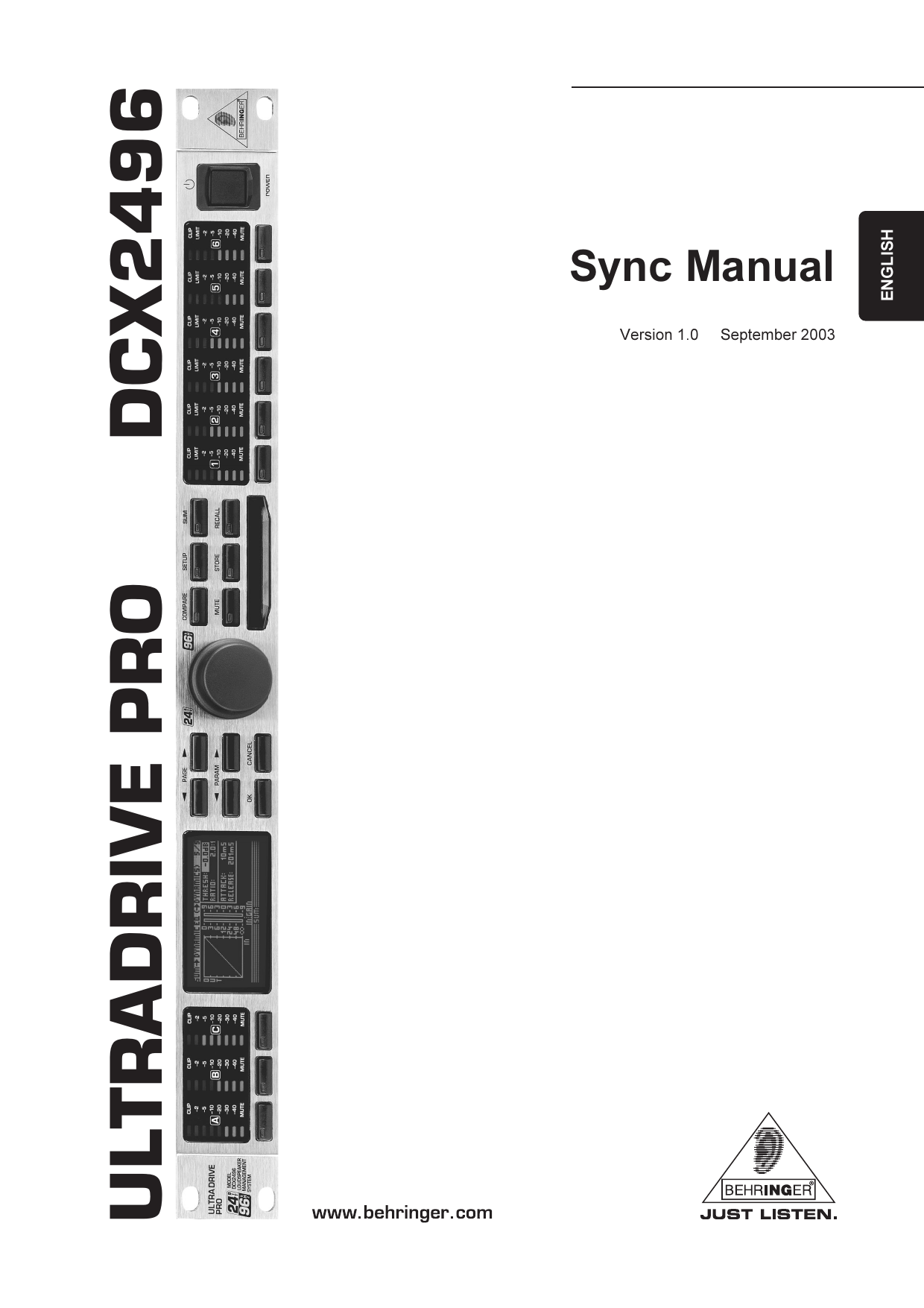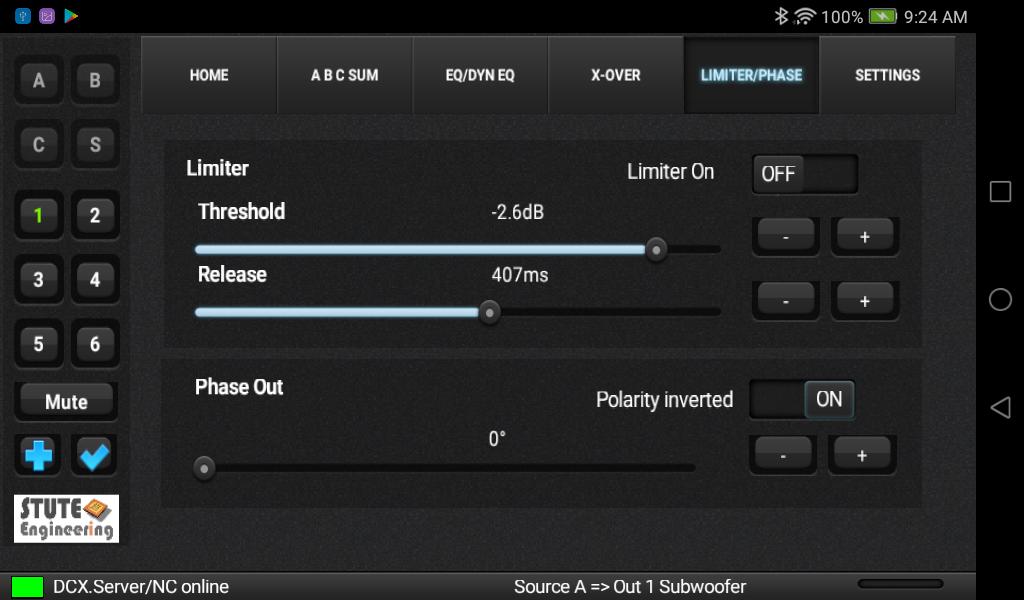I bricked my DCX2496 while updating the firmware, but I got it back.
Feb 20, 2015 Remotely controlling the DCX2496 on an Iphone using a Raspbery pi running NodeJS. DCX2496 Remote Root Soundsystem. Quick Setup of The Behringer DCX2496 as a 2 Way Stereo Crossover. DCX.Client: Network remote control app for your Behringer DCX2496 device. Adjust easily the inputs and outputs via your mobile phone, tablet or laptop. You need:. This DCX.Client app: The user interface to control your DCX2496. The software DCX.Server (for a MS-Windows PC with USB-RS232 interface) or the DCX.NC controller (stand-alone LAN Network receiver for the DCX2496).

I decided to update my DCX2496 from FW 1.14 to 1.16 using Behringers software. This update failed, with the software reporting a failure.
This bricked the unit and it would stay at the boot splash.
Recovery is possible from this state by rebooting the unit while holding the A channel button, this puts it into software load mode.
I was able to successfully update the software to 1.16 by using the DCX Remote 1.16a software.
Updated: I have been informed by a Brazilian reader that the 1.16a software didn't work for them. It may have been a coincidence that it worked for me. Manually flashing the ROM should work in all cases.
I then decided to read back the EEPROM (AM29F040B) and archive it in case of failure. This way you could simply pop out the EEPROM and rewrite it in a EEPROM burner and skip the entire remote software.
Note that this EEPROM image contains my settings, I suggest either writing down all the settings or using the DCX Remote software over RS-232/485 to download all your settings before update. Then you can upload these after the update to restore your settings.
Note also that the .bin file provided by Behringer has some kind of compression or an offset involved so it can't be written directly to the EEPROM (it's a socketed EEPROM... Come on Behringer.).
Download link: DCX2496_1_16.zip
The DCX2496 electronic crossover has become quite popular in the DIY world and people started using it also in HI-FI setups due to its versatility. However like many Pro gear it has some weaknesses that should be addressed in order to get out a better sound quality from it. The worst components used in Behringer equipment are the electrolytic capacitors (followed by OP-AMPs); in addition to the DCX2496 I own also a SRC2496 a DSP2024 and an EP2000 power amplifier and all of them use caps named XUNDA … which I never heard of till the day I opened a Behringer unit .
Because one of the most important part of a HI-FI unit is the power supply I started making some changes in that of the DCX, which is also a switch-mode unit with all its pros and cons, with the second consisting typically in the residual of the switching frequency.
The unit, also used in the DEQ2406 and probably others, provide the following voltages:
- +3.3V for many digital components, but not for the ADCs and the DACs
- +5V which its main task it to supply the CS8420; this voltage is very important because Behringer decided to provide a unique supply for both the digital and the analog part of the receiver, accurately following the CS8420 specs for this approach… and the analog supply of the CS8420 has a direct relation to jitter when using the Digital input of the unit. this leg is also used as an input for the circuitry which creates the 3.3V for the digital supply of the ADCs and DACs.
- +8.7V which is used as a source for a couple of 7815 to crate the +5V for all the analog parts of the ADCs and DACs, and this plays an important role in the analog performance of the whole unit. One of the +5Va legs is used also as a reference voltage to create the 3.3V for the digital supply of the ADCs and DACs through a transistor.

Here is the schema of the supply components just after the power connector on the DSP board (Fig. 1)
The +3.3VA despite the name is used to to supply the VD pins of the ADCs and DACs
Starting from this schema (Fig. 2)
I replaced all the electrolytic capacitors with Panasonic FM:
- the +3.3V line now has a 2220uF (C13) before L2 and a 1200uF after (C11)
- the +9V line has C3 replaced with 2200uF
- the +-15V line has 820uF for C4 and C5 and 47uF for C1 and C2
Here is a snapshot of the replacement (Fig. 3)
Then I took some photo of the supply voltages at 10mV per vertical division, with the first run at 5mS horizontal division and the second at 10uS horizontal division
3.3V – 10mV/Div – 5ms (Fig. 4)
5V – 10mV/Div – 5ms (Fig. 5)
8.7V – 10mV/Div – 5ms (Fig. 6)
15V – 10mV/Div – 5ms (Fig. 7)
3.3V – 10mV/Div – 10uS (Fig. 8)
5V – 10mV/Div – 10uS (Fig. 9)
8.7V – 10mV/Div – 10uS (Fig. 10)
+-15V – 10mV/Div – 10uS (Fig. 11)
The 3.3, 5 and 8.7 have a ripple of about 15mV peak to peak, but it is not clear to me where the 200Hz frequency (5ms period = 200Hz) comes from … The +-15V seems very clear with few mV ripple (Fig. 7 ), but with a strange “shadow” surrounding it; this comes clear at 10uS resolution, where we can really see over imposed spikes with 8uS period, which translates into 125KHz frequency.
The +-15V is the worst, with more than 30mV spikes over the fundamental, and the 8.7V showing a little more than 20mV of the same spikes. The 3.3V and the 5V remain within 10mV; it is a good result considering that the 5V goes directly to the VA pin of the CS8420 and has a direct impact on jitter.

I didn’t take any photo, but I can confirm that the scope traces with the stock capacitors were remarkably worse than the above, in both the 5ms and 10uS scope resolution; the immediate result of this mod has been a reduction in the annoying hiss You can clearly ear when the DCX is connected to the amps. In addition to this for sure also the complete recap of the DSP board with OS-CONs around the ADCs, DACs, and CS8240 played an important role.
Behringer Ultracurve Pro Deq2496 Reviews
Fig. 12
Fig. 13
The OS-CONs near the DACs are for VREF and VCOM while those near the ADCs are for VREF; on the bottom side of the board there are Panasonic 10uF directly soldered on the 100nF bypass for VD and VA of the DACs and ADCs, and on the 100nF which bypass the two VCOM( of each ADC.
Behringer Dcx2496 Remote Software Downloads
As You can see in Fig. 12 there are also two resistors and a capacitor in place, and create a RC filter on the 8.7V line, an action I took after having thought to a way to improve that supply, which has probably the most direct impact on the whole analog performance of the unit (together with the OP-APMs); it is the most simple to implement and provide very good results.
2Ohm + 1800uF cause a reduction from 8.7V to 8.2 and provide the below scope traces, which are a big step forward compared to Fig. 6 and Fig. 10.
8.2V – 10mV/Div – 5mS
8.2V – 10mV/Div – 10uS

With all this changes the output trace still show the 8us period spikes, which are for sure a direct result of the bad appearance of the +-15V line.
Output – 10mV/div – 10uS
My next step will be try to optimize the +-15V line and then make a comparison with the Awdiy “Power Supply” module… Stay tuned!